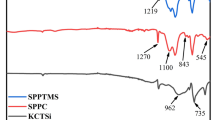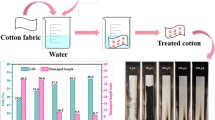Abstract
A novel cyclic-shaped copolymer containing silicon and phosphorus, poly (tetramethylcyclosiloxyl spirocyclic pentaerythritol diphosphonate) (PCTSi) was successfully synthesized and characterized by Fourier transform infrared spectra (FT-IR), 1H and 13C nuclear magnetic resonance (1H NMR and 13C NMR) for the preparation of flame retardant and hydrophobic cotton fabrics. The surface morphology of treated cotton fabrics was characterized by scanning electron microscopy (SEM) and energy dispersive spectrometer (EDS). The thermal degradation and combustion properties of cotton fabrics before and after treatment were investigated by thermogravimetric (TG) analysis, limiting oxygen index (LOI) test, vertical burning test and cone calorimetry test. After treated with PCTSi, the LOI value of coton fabrics increased to 29.5%, which was significantly higher than untreated cotton fabrics and the LOI value remained at above of 26.0% after 20 washing times. In the vertical burning test, the PCTSi treated cotton fabrics showed no afterflame and afterglow with a minimum char length of 8.5 cm. Thermogravimetric analysis coupled with Fourier transform infrared analysis (TG-FTIR) results indicated that flame-retardant cotton fabrics released nonflammable gases and less flammable gases than the untreated cotton fabrics. X-ray diffraction analysis demonstrated that the crystal structures of the PCTSi-treated cotton were almost unaffected. According to the results of TG-FTIR, SEM, EDS, and analyses of char residues, the cyclic-shaped copolymer can significantly improve flame retardant performance of cotton fabric by promoting the generation of char layer and the release of noncombustible volatiles. The treated cotton fabrics showed excellent hydrophobic properties, which reached a contact angle (CA) of 150° compared with cotton fabrics without treatment. In addition, 119.18° of CA and 26.0% of LOI value can be maintained after 20 washing times.
Graphic abstract














Similar content being viewed by others
References
Alongi J, Malucelli G (2015) Cotton flame retardancy: state of the art and future perspectives. RSC Adv 5:24239–24263. https://doi.org/10.1039/c5ra01176k
Alongi J, Ciobanu M, Malucelli G (2012) Sol–gel treatments on cotton fabrics for improving thermal and flame stability: effect of the structure of the alkoxysilane precursor. Carbohydr Polym 87:627–635. https://doi.org/10.1016/j.carbpol.2011.08.036
Carosio F, Fontaine G, Alongi J, Bourbigot S (2015) Starch-based layer by layer assembly: efficient and sustainable approach to cotton fire protection. ACS Appl Mater Interfaces 7:12158–12167. https://doi.org/10.1021/acsami.5b02507
Chen G-H, Yang B, Wang Y-Z (2006) A novel flame retardant of spirocyclic pentaerythritol bisphosphorate for epoxy resins. J Appl Polym Sci 102:4978–4982. https://doi.org/10.1002/app.24881
Chen C, Gu X, Jin X, Sun J, Zhang S (2017a) The effect of chitosan on the flammability and thermal stability of polylactic acid/ammonium polyphosphate biocomposites. Carbohydr Polym 157:1586–1593. https://doi.org/10.1016/j.carbpol.2016.11.035
Chen Z, Dong C, Li Q, Bai Y, Lu Z (2017b) Preparation of linear piperazine/phosphorous/polysiloxane copolymer and its application on cotton fabrics. J Therm Anal Calorim 130:1997–2005. https://doi.org/10.1007/s10973-017-6541-8
Chen Z, Dong C, Li Q, Pu Y, Lu Z (2018) Multifunctional, hydrophobic and flame-retarded cotton fabrics modified with liner piperzine/phosphorous/polysiloxane copolymer. Fibers Polym 19:861–867. https://doi.org/10.1007/s12221-018-7874-z
Dong C, Lu Z, Zhang F (2015a) Preparation and properties of cotton fabrics treated with a novel guanidyl- and phosphorus-containing polysiloxane antimicrobial and flame retardant. Mater Lett 142:35–37. https://doi.org/10.1016/j.matlet.2014.11.138
Dong C, Lu Z, Zhang F, Zhu P, Wang P, Che Y, Sui S (2015b) Combustion behaviors of cotton fabrics treated by a novel nitrogen- and phosphorus-containing polysiloxane flame retardant. J Therm Anal Calorim 123:535–544. https://doi.org/10.1007/s10973-015-4914-4
Dong C, Lu Z, Zhang F, Zhu P, Zhang L, Sui S (2015c) Preparation and properties of cotton fabrics treated with a novel polysiloxane water repellent and flame retardant. Mater Lett 152:276–279. https://doi.org/10.1016/j.matlet.2015.03.132
Dong C et al (2016) Flammability and thermal properties of cotton fabrics modified with a novel flame retardant containing triazine and phosphorus components. Text Res J 87:1367–1376. https://doi.org/10.1177/0040517516652349
Edwards B, Rudolf S, Hauser P, El-Shafei A (2015) Preparation, polymerization, and performance evaluation of halogen-free radiation curable flame retardant monomers for cotton substrates. Ind Eng Chem Res 54:577–584. https://doi.org/10.1021/ie502915t
Fei Z, Liu B, Zhu M, Wang W, Yu D (2018) Antibacterial finishing of cotton fabrics based on thiol–maleimide click chemistry. Cellulose 25:3179–3188. https://doi.org/10.1007/s10570-018-1771-x
Feng Z et al (2019) Modification of mesoporous silica with phosphotungstic acid and its effects on the combustion and thermal behavior of polylactic acid composites. Polym Degrad Stab 160:24–34. https://doi.org/10.1016/j.polymdegradstab.2018.12.004
Hassanpour A, Asghari S, Lakouraj MM (2017) Synthesis, characterization and antibacterial evaluation of nanofibrillated cellulose grafted by a novel quinolinium silane salt. RSC Adv 7:23907–23916. https://doi.org/10.1039/c7ra02765f
He P et al (2018) Preparation and flame retardancy of reactive flame retardant for cotton fabric. J Therm Anal Calorim 132:1771–1781. https://doi.org/10.1007/s10973-018-7057-6
Hou Y, Hu W, Hu Y (2017) Preparation of layered organic–inorganic aluminum phosphonate for enhancing fire safety of polystyrene. Mater Chem Phys 196:109–117. https://doi.org/10.1016/j.matchemphys.2017.04.057
Hu X, Guo Y, Chen L, Wang X, Li L, Wang Y (2012) A novel polymeric intumescent flame retardant: synthesis, thermal degradation mechanism and application in ABS copolymer. Polym Degrad Stab 97:1772–1778. https://doi.org/10.1016/j.polymdegradstab.2012.06.009
Jia Y, Hu Y, Zheng D, Zhang G, Zhang F, Liang Y (2016) Synthesis and evaluation of an efficient, durable, and environmentally friendly flame retardant for cotton. Cellulose 24:1159–1170. https://doi.org/10.1007/s10570-016-1163-z
Jiang Z, Li H, He Y, Liu Y, Dong C, Zhu P (2019a) Flame retardancy and thermal behavior of cotton fabrics based on a novel phosphorus-containing siloxane. Appl Surf Sci 479:765–775. https://doi.org/10.1016/j.apsusc.2019.02.159
Jiang Z, Xu D, Ma X, Liu J, Zhu P (2019b) Facile synthesis of novel reactive phosphoramidate siloxane and application to flame retardant cellulose fabrics. Cellulose 26:5783–5796. https://doi.org/10.1007/s10570-019-02465-2
Jin X et al (2017a) The fire performance of polylactic acid containing a novel intumescent flame retardant and intercalated layered double hydroxides. J Mater Sci 52:12235–12250. https://doi.org/10.1007/s10853-017-1354-5
Jin X et al (2017b) Preparation of a novel intumescent flame retardant based on supramolecular interactions and its application in polyamide 11. ACS Appl Mater Interfaces 9:24964–24975. https://doi.org/10.1021/acsami.7b06250
Kan CW, Yuen CWM, Tsoi WY (2011) Using atmospheric pressure plasma for enhancing the deposition of printing paste on cotton fabric for digital ink-jet printing. Cellulose 18:827–839. https://doi.org/10.1007/s10570-011-9522-2
Kaul PK, Samson AJ, Selvan GT, Enoch I, Selvakumar PM (2017) Synergistic effect of LDH in the presence of organophosphate on thermal and flammable properties of an epoxy nanocomposite. Appl Clay Sci 135:234–243. https://doi.org/10.1016/j.clay.2016.09.031
Kundu CK, Wang X, Hou Y, Hu Y (2018) Construction of flame retardant coating on polyamide 6.6 via UV grafting of phosphorylated chitosan and sol-gel process of organo-silane. Carbohydr Polym 181:833–840. https://doi.org/10.1016/j.carbpol.2017.11.069
Kwong HY, Wong MH, Wong YW, Wong KH (2007) Superhydrophobicity of polytetrafluoroethylene thin film fabricated by pulsed laser deposition. Appl Surf Sci 253:8841–8845. https://doi.org/10.1016/j.apsusc.2007.04.036
Li P, Wang B, Xu Y-J, Jiang Z, Dong C, Liu Y, Zhu P (2019a) Ecofriendly flame-retardant cotton fabrics: preparation, flame retardancy, thermal degradation properties, and mechanism. ACS Sustain Chem Eng 7:19246–19256. https://doi.org/10.1021/acssuschemeng.9b05523
Li S, Zhong L, Huang S, Wang D, Zhang F, Zhang G (2019b) A novel flame retardant with reactive ammonium phosphate groups and polymerizing ability for preparing durable flame retardant and stiff cotton fabric. Polym Degrad Stab 164:145–156. https://doi.org/10.1016/j.polymdegradstab.2019.04.009
Liang T, Jiang Z, Wang C, Liu J (2017) A facile one-step synthesis of flame-retardant coatings on cotton fabric via ultrasound irradiation. J Appl Polym Sci 134:45114. https://doi.org/10.1002/app.45114
Liao F, Zhou L, Ju Y, Yang Y, Wang X (2014) Synthesis of a novel phosphorus–nitrogen-silicon polymeric flame retardant and its application in poly(lactic acid). Ind Eng Chem Res 53:10015–10023. https://doi.org/10.1021/ie5008745
Lin D, Zeng X, Li H, Lai X (2018) Facile fabrication of superhydrophobic and flame-retardant coatings on cotton fabrics via layer-by-layer assembly. Cellulose 25:3135–3149. https://doi.org/10.1007/s10570-018-1748-9
Liu Y et al (2016) Effect of phosphorus-containing inorganic–organic hybrid coating on the flammability of cotton fabrics: synthesis, characterization and flammability. Chem Eng J 294:167–175. https://doi.org/10.1016/j.cej.2016.02.080
Liu X, Gu X, Sun J, Zhang S (2017) Preparation and characterization of chitosan derivatives and their application as flame retardants in thermoplastic polyurethane. Carbohydr Polym 167:356–363. https://doi.org/10.1016/j.carbpol.2017.03.011
Liu Y, Wang Q-Q, Jiang Z-M, Zhang C-J, Li Z-F, Chen H-Q, Zhu P (2018) Effect of chitosan on the fire retardancy and thermal degradation properties of coated cotton fabrics with sodium phytate and APTES by LBL assembly. J Anal Appl Pyrol 135:289–298. https://doi.org/10.1016/j.jaap.2018.08.024
Liu J, Dong C, Wei D, Zhang Z, Xie W, Li Q, Lu Z (2019a) Multifunctional antibacterial and hydrophobic cotton fabrics treated with cyclic polysiloxane quaternary ammonium salt. Fibers Polym 20:1368–1374. https://doi.org/10.1007/s12221-019-1091-2
Liu M, Huang S, Zhang G, Zhang F (2019b) An efficient anti-flaming phosphorus-containing guanazole derivative for cotton fabric. Cellulose 26:2791–2804. https://doi.org/10.1007/s10570-019-02275-6
Liu X, Qi S, Li H, Sun J, Gu X, Zhang S, Grunlan JC (2019c) Combination intumescent and kaolin-filled multilayer nanocoatings that reduce polyurethane flammability. Macromol Mater Eng 304:1800531. https://doi.org/10.1002/mame.201800531
Lu Z, Liu J, Dong C, Zhang Z, Wei D (2019) Durable multifunctional antibacterial and hydrophobic cotton fabrics modified with linear fluorinated pyridinium polysiloxane. Cellulose 26:7483–7494. https://doi.org/10.1007/s10570-019-02582-y
Ma H, Fang Z (2012) Synthesis and carbonization chemistry of a phosphorous–nitrogen based intumescent flame retardant. Thermochim Acta 543:130–136. https://doi.org/10.1016/j.tca.2012.05.021
Nie S, Jin D, Yang J-n, Dai G, Luo Y (2019) Fabrication of environmentally-benign flame retardant cotton fabrics with hydrophobicity by a facile chemical modification. Cellulose 26:5147–5158. https://doi.org/10.1007/s10570-019-02431-y
Pakhomov AA et al (2016) Synthesis and photophysical properties of a new BODIPY-based siloxane dye. Tetrahedron Lett 57:979–982. https://doi.org/10.1016/j.tetlet.2016.01.059
Sun D, Wang W, Yu D (2017) Highly hydrophobic cotton fabrics prepared with fluorine-free functionalized silsesquioxanes. Cellulose 24:4519–4531. https://doi.org/10.1007/s10570-017-1388-5
Valtola L, Koponen A, Karesoja M, Hietala S, Laukkanen A, Tenhu H, Denifl P (2009) Tailored surface properties of semi-fluorinated block copolymers by electrospinning. Polymer 50:3103–3110. https://doi.org/10.1016/j.polymer.2009.04.078
Wang X, Xing W, Feng X, Yu B, Song L, Hu Y (2014) Functionalization of graphene with grafted polyphosphamide for flame retardant epoxy composites: synthesis, flammability and mechanism. Polym Chem 5:1145–1154. https://doi.org/10.1039/c3py00963g
Wei D, Dong C, Chen Z, Liu J, Li Q, Lu Z (2019) A novel cyclic copolymer containing Si/P/N used as flame retardant and water repellent agent on cotton fabrics. J Appl Polym Sci 136:47280. https://doi.org/10.1002/app.47280
Xiao D, Li Z, De Juan S, Gohs U, Wagenknecht U, Voit B, Wang D-Y (2016) Preparation, fire behavior and thermal stability of a novel flame retardant polypropylene system. J Therm Anal Calorim 125:321–329. https://doi.org/10.1007/s10973-016-5352-7
Xie H, Lai X, Li H, Zeng X (2018) Fabrication of ZrP nanosheet decorated macromolecular charring agent and its efficient synergism with ammonium polyphosphate in flame-retarding polypropylene. Compos Part A Appl Sci Manuf 105:223–234. https://doi.org/10.1016/j.compositesa.2017.12.001
Xiong J-F, Wang Q-F, Peng P, Shi J, Wang Z-Y, Yang C-l (2014) Design, synthesis, and characterization of a potential flame retardant poly(lactic acid-co-pyrimidine-2,4,5,6-tetramine) via direct melt polycondensation. J Appl Polym Sci 131:40275. https://doi.org/10.1002/app.40275
Xu G, Cheng J, Wu H, Lin Z, Zhang Y, Wang H (2013) Functionalized carbon nanotubes with oligomeric intumescent flame retardant for reducing the agglomeration and flammability of poly(ethylene vinyl acetate) nanocomposites. Polym Composite 34:109–121. https://doi.org/10.1002/pc.22382
Xu M, Zhao W, Li B (2014) Synthesis of a novel curing agent containing organophosphorus and its application in flame-retarded epoxy resins. J Appl Polym Sci 131:41159. https://doi.org/10.1002/app.41159
Zhao B, Liu Y-T, Zhang C-Y, Liu D-Y, Li F, Liu Y-Q (2017a) A novel phosphoramidate and its application on cotton fabrics: synthesis, flammability and thermal degradation. J Anal Appl Pyrol 125:109–116. https://doi.org/10.1016/j.jaap.2017.04.011
Zhao C, Li J, He B, Zhao L (2017b) Fabrication of hydrophobic biocomposite by combining cellulosic fibers with polyhydroxyalkanoate. Cellulose 24:2265–2274. https://doi.org/10.1007/s10570-017-1235-8
Zhao D, Wang J, Wang X-L, Wang Y-Z (2018) Highly thermostable and durably flame-retardant unsaturated polyester modified by a novel polymeric flame retardant containing Schiff base and spirocyclic structures. Chem Eng J 344:419–430. https://doi.org/10.1016/j.cej.2018.03.102
Zheng D, Zhou J, Zhong L, Zhang F, Zhang G (2016) A novel durable and high-phosphorous-containing flame retardant for cotton fabrics. Cellulose 23:2211–2220. https://doi.org/10.1007/s10570-016-0949-3
Zheng F-T, Yamamoto K, Kanezashi M, Tsuru T, Ohshita J (2018) Preparation of bridged silica RO membranes from copolymerization of bis(triethoxysilyl)ethene/(hydroxymethyl)triethoxysilane. Effects of ethenylene-bridge enhancing water permeability. J Membr Sci 546:173–178. https://doi.org/10.1016/j.memsci.2017.10.025
Acknowledgments
This work was supported by Natural Science Foundation of Shandong Province (Grant Number ZR2018MEM026).
Author information
Authors and Affiliations
Corresponding authors
Additional information
Publisher's Note
Springer Nature remains neutral with regard to jurisdictional claims in published maps and institutional affiliations.
Electronic supplementary material
Below is the link to the electronic supplementary material.
Rights and permissions
About this article
Cite this article
Liu, J., Dong, C., Zhang, Z. et al. Multifunctional flame-retarded and hydrophobic cotton fabrics modified with a cyclic phosphorus/polysiloxane copolymer. Cellulose 27, 3531–3549 (2020). https://doi.org/10.1007/s10570-020-03016-w
Received:
Accepted:
Published:
Issue Date:
DOI: https://doi.org/10.1007/s10570-020-03016-w




